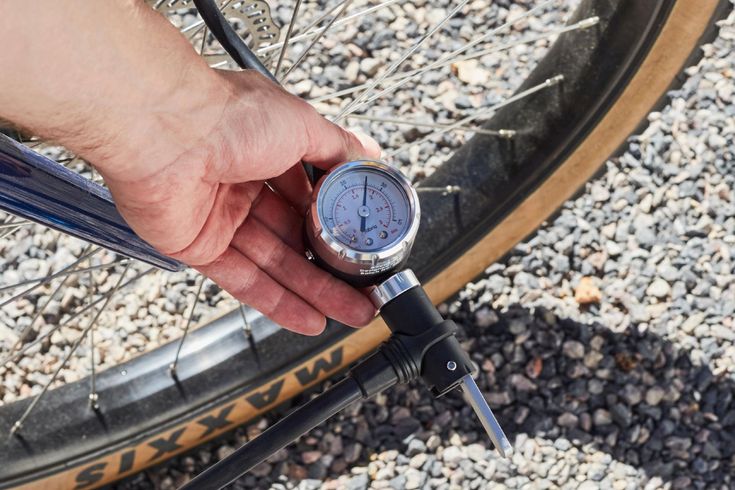Maintaining proper tire inflation is relatively simple and essential to the overall tire performance of your vehicle. A properly inflated tire will provide longer life, quicker steering response, better fuel efficiency and a smoother ride than an improperly inflated tire. Both underinflation and overinflation can cause headaches like premature treadwear and possible tire failure. The best way to ensure you're getting the most out of your tires is to check your tire pressure on a monthly basis.
Knowing how to use a tire pressure gauge is very simple. Here’s how to check tire pressure and refill your tires.
Items You Need When Checking Tire Pressure
Tire pressure gauge
Air compressor
Pen and paper
Your tire pressure gauge can be digital or standard. Auto parts stores typically carry both. Many auto parts stores sell portable air compressors that run from your car battery or 12v power port. Alternatively, you can use the air compressor found at most gas stations. They usually cost $0.50 or $1.00 to use.
Vehicle manufacturers specify PSI – literally “pounds per square inch” of pressure – assuming tires are cold. Tires are considered cold when the vehicle has been parked for three hours or more, or if the vehicle has been driven less than a mile (1.6 km) at moderate speed. PSI is the unit your pressure gauge uses to provide readings.
Look on the driver’s side door jamb or your owner’s manual to find the recommended cold tire PSI for your front and rear tires. If you cannot find it, you should consult your vehicle dealer, manufacturer, or a qualified tire professional.
If your front and rear tires require different pressure levels, write down the correct PSI for each to avoid getting confused as you move around your vehicle checking tire pressure.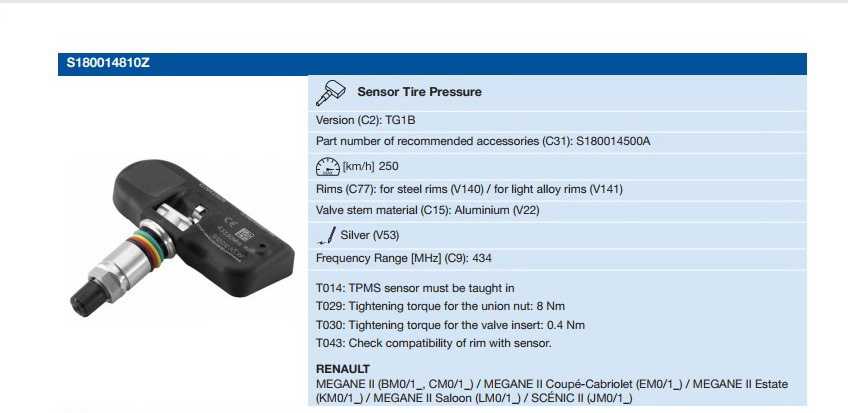
Remove the valve cap from one of your tires. Then place the pressure gauge on the valve stem and press down hard enough so the hiss sound disappears and your gauge provides a reading. With a standard gauge, the air pressure will push a small bar out from the bottom of the gauge. Measurement units are etched into the bar. A digital gauge will show you the reading on a screen.
Write down the reading and repeat this process for all four tires.
Use an air compressor to refill any tires with low pressure. Many air compressors are different, so read directions carefully to be sure you’re using it correctly.
If you’re using the air compressor at a gas station, be sure to park so that the hose will reach all four tires. Insert change into the machine until you hear the motor running. Fill each tire by placing the end of the hose over the valve stem and pressing on the lever.
Using a gas station air compressor means your tires might be “hot.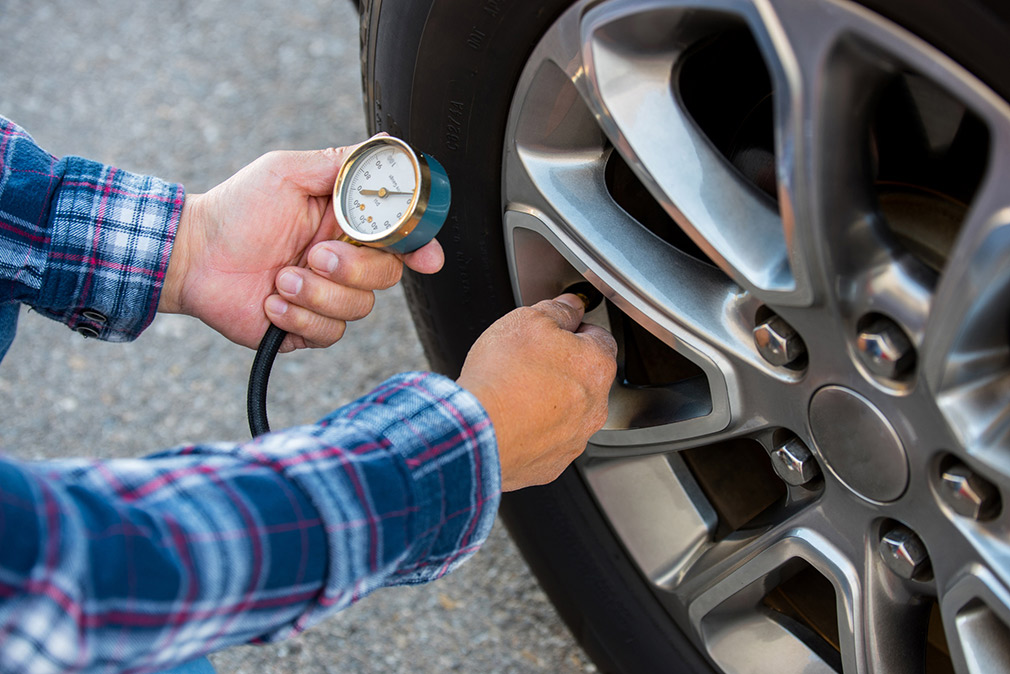 ” If it is necessary to adjust inflation pressure when tires are “hot”, set their pressure to 4 psi (14 kPa) above the recommended cold inflation pressure. Recheck the inflation pressure when the tires are cold.
” If it is necessary to adjust inflation pressure when tires are “hot”, set their pressure to 4 psi (14 kPa) above the recommended cold inflation pressure. Recheck the inflation pressure when the tires are cold.
After filling your tires, use the gauge to check pressure again. At this point, it’s ok if you overfilled the tires because you can always let some air back out. Never drive on overinflated tires. Overinflation can result in decreased traction, premature wear, and decreased impact absorption.
Make the above procedure a monthly ritual. Regularly checking your tire pressure is the best way to ensure your tires never dip far below the optimal PSI.
Accuracy matters and you should keep that in mind when choosing a gauge. For just a few dollars, you can find a quality, accurate tire pressure gauge that gives accurate readings. If you’re not sure which one to purchase, ask a professional technician which he or she prefers.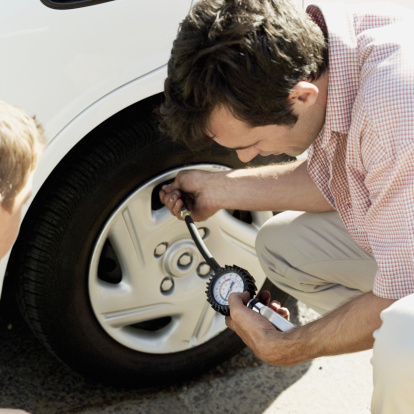
A digital tire pressure gauge will provide accurate readings, but don’t forget that it operates on a battery. If you think having to replace the battery will prevent you from using it, it’s best to go with a standard gauge.
It’s best to use your personal tire gauge versus those available attached to air hoses at service stations. Of all the pressure gauges out there, they’re the most likely to be weathered, and possibly inaccurate.
There’s never a good time for a flat. That’s why Bridgestone DriveGuard tires are masterfully engineered to keep you moving for up to 50 miles at speeds up to 50 MPH without disruption.
There’s never a good time for a flat. That’s why Bridgestone DriveGuard tires are masterfully engineered to keep you moving for up to 50 miles at speeds up to 50 MPH without disruption.
See Details Find Your Fit
 Make it a part of your monthly maintenance routine in a matter of minutes.
Make it a part of your monthly maintenance routine in a matter of minutes.Every editorial product is independently selected, though we may be compensated or receive an affiliate commission if you buy something through our links. Ratings and prices are accurate and items are in stock as of time of publication.
1 / 7
Driving on improperly-inflated tires can wear out the tread and cause steering problems. That’s why it’s important to check your tire pressure regularly.
Fortunately, checking tire pressure only requires two tools — a tire pressure gauge and an air compressor. Most gas stations have an air compressor so you only need to own one tool. The whole process is relatively quick, too. In a matter of minutes you’ve done a lot to ensure a safe and smooth ride.
Before you begin, make sure the car has been parked for three to four hours so you get an accurate reading from the gauge. If you drive to a gas station to use an air compressor, try to find one less than a mile away.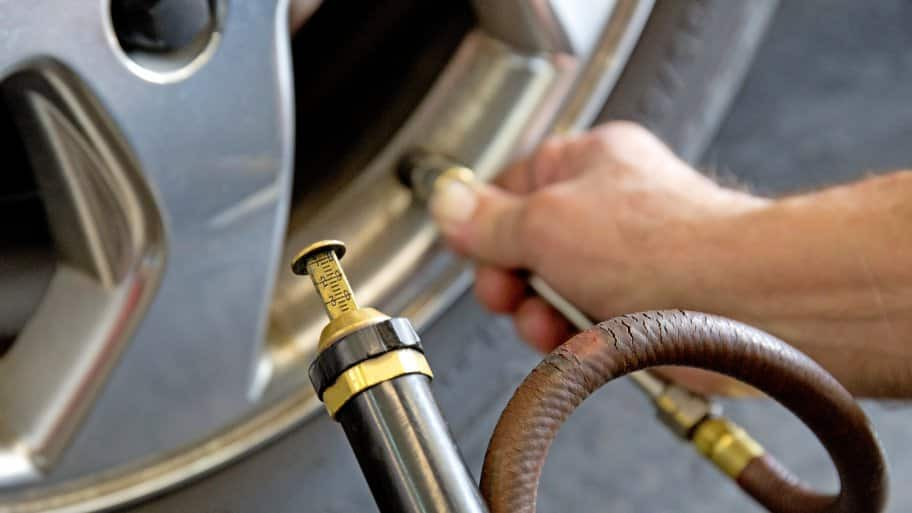
2 / 7
Veronica Graham
3 / 7
Veronica Graham
The driver’s side door jamb typically has a sticker with the recommended PSI (pounds per square inch) for the tires. Most manufacturers recommend 30 to 32 PSI for all four tires, although some cars will have different PSI recommendations for the front tires and back tires.![]() If you don’t see the recommended PSI on your door jamb, check your owner’s manual.
If you don’t see the recommended PSI on your door jamb, check your owner’s manual.
4 / 7
Veronica Graham
Unscrew the cap on the tire air valve and place it somewhere safe.
5 / 7
Veronica Graham
Press the gauge onto the tire air valve straight on, and press it hard. This creates a tight seal around the tire air valve so you don’t accidentally release air from the tire. You’ll hear a hissing sound if air is coming out. A small bar with numbered notches will pop out of the pencil gauge with the tire pressure reading.
6 / 7
Veronica Graham
Fill up the tire by pressing the air compressor nozzle onto the tire air valve in the same manner as the gauge — hard and straight-on to create a tight seal. Hold the nozzle onto the tire air valve for about 30 seconds to one minute, depending on how low the initial reading is. Repeat Step Three to get the new reading. Add or release air as needed to reach the recommended PSI.
Hold the nozzle onto the tire air valve for about 30 seconds to one minute, depending on how low the initial reading is. Repeat Step Three to get the new reading. Add or release air as needed to reach the recommended PSI.
7 / 7
Veronica Graham
Repeat Steps Three and Four on the three remaining tires.
Originally Published: April 16, 2020
Veronica Graham
Veronica Graham is a freelance writer in Arlington, Mass. Her work has appeared in The Washington Post and SheKnows. She's covered health, politics, high school football and everything in between. Graham enjoys learning about the world through a variety of lenses as a reporter.
Home / Articles / How to check tire pressure correctly
The tire contains air, but this air tends to go out and little by little the tire goes down.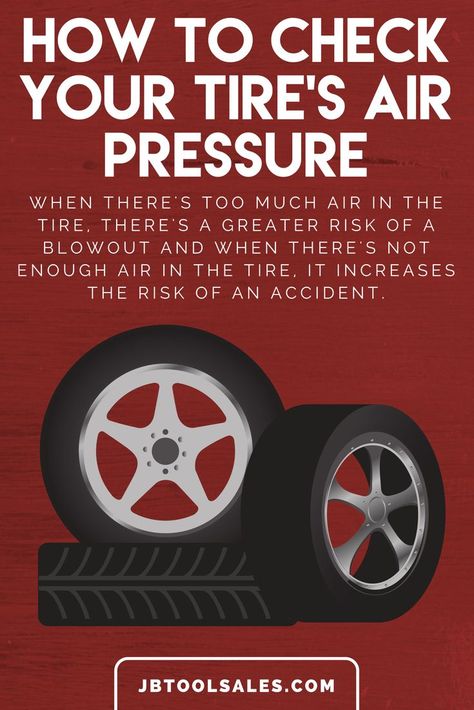 The pressure in the tire drops, which entails certain consequences. Because the tire distorts more under load, the tire heats up more and wears out much faster. Control accuracy deteriorates and fuel consumption increases. In the worst case, this will lead to loss of control of the car and the tire may burst. Therefore, it is extremely important to constantly check the pressure in car tires. However, this operation requires some explanation.
The pressure in the tire drops, which entails certain consequences. Because the tire distorts more under load, the tire heats up more and wears out much faster. Control accuracy deteriorates and fuel consumption increases. In the worst case, this will lead to loss of control of the car and the tire may burst. Therefore, it is extremely important to constantly check the pressure in car tires. However, this operation requires some explanation.
In fact, the required tire pressure for various types of machines is usually given for cold tires.
In fact, the required tire pressure for various types of machines is usually given for cold tires. It's a tire that hasn't moved for at least the last two hours. The tire heats up quickly. For example, already after 3 kilometers of slow driving around the city. This means that in most cases the tire will be hot during the pressure test. In this case, it is considered normal that the pressure, which increases with increasing temperature, will be higher than that set for the cold Shiga.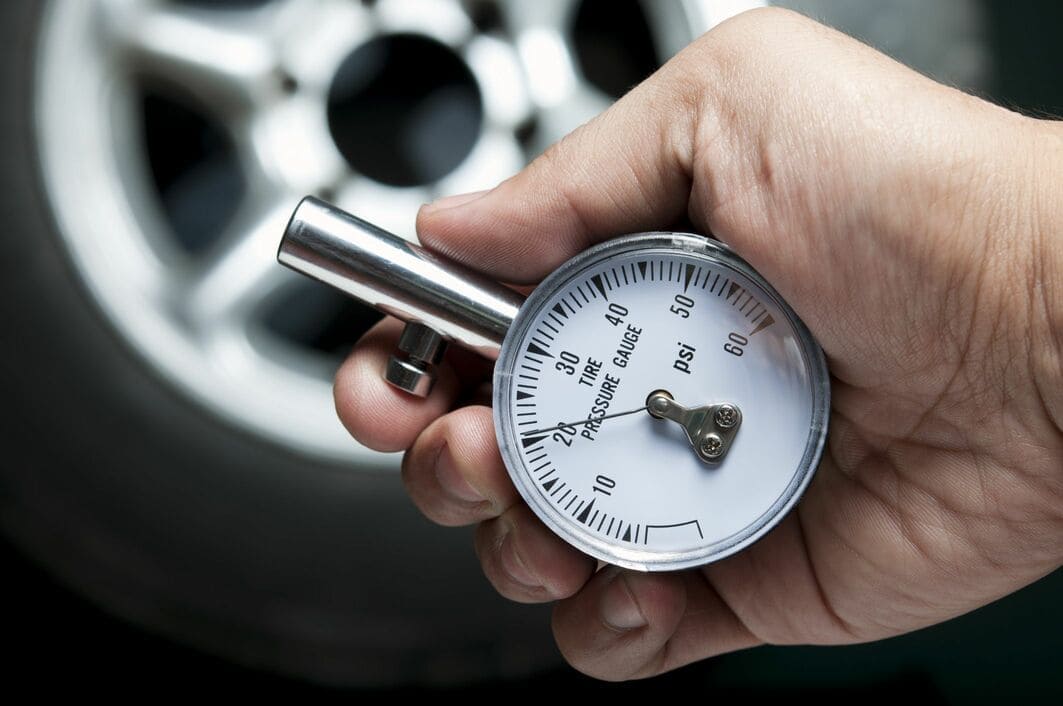 More precisely, the pressure in hot tires should exceed the pressure in cold ones by 0.3 atmospheres. If this is not the case, the pressure should be brought back to normal. For example, let's take a tire in a cold state and a recommended pressure of 2 atmospheres. After the trip, the tire has warmed up, and the pressure gauge shows a pressure of about 2.1 atmospheres. Although this pressure is higher than recommended for cold ones, nevertheless, the tires can be pumped up by about two tenths of an atmosphere, that is, in order to reach the normal figure for a hot tire of 2.3 atmospheres.
More precisely, the pressure in hot tires should exceed the pressure in cold ones by 0.3 atmospheres. If this is not the case, the pressure should be brought back to normal. For example, let's take a tire in a cold state and a recommended pressure of 2 atmospheres. After the trip, the tire has warmed up, and the pressure gauge shows a pressure of about 2.1 atmospheres. Although this pressure is higher than recommended for cold ones, nevertheless, the tires can be pumped up by about two tenths of an atmosphere, that is, in order to reach the normal figure for a hot tire of 2.3 atmospheres.
What to do if the pressure gauge reads more than 2.3 tenths of an atmosphere? Then the golden rule applies - never run a burning tire. In other circumstances, more pressure than recommended may be required, such as 0.2 atmosphere more if you plan to drive on the highway for more than 2 hours. Or 0.3-0.4 more, in case of using a trailer. Or even more, if recommended by the manufacturer. As you can see, tire pressure requires special attention. It is necessary to check the pressure at least monthly, and systematically before long trips. Don't forget to screw the caps back on the nipples. And one more thing. Check the pressure in the spare tire as well.
It is necessary to check the pressure at least monthly, and systematically before long trips. Don't forget to screw the caps back on the nipples. And one more thing. Check the pressure in the spare tire as well.
How do we work?
Contact us
By phone or leave a request on the site.
The manager of the company will contact you and place an order
Will clarify your order. Give an estimate of the cost of the work.
A master will come to you and perform services
All equipment for this will be in a special van.
If you need advice,
just tell our operator about your problem
+7 (495) 374-89-07
You can also contact us through the website by leaving a request.
| Book a pickup. |
Call now and in 1 minute a mobile tire service will go to you.
| Call a technician |
20.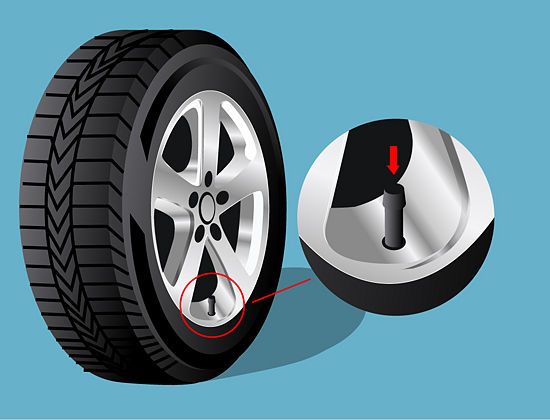 01.2022
01.2022
Tires experience the greatest load in the car and constant contact with the road surface, which leads to their rapid tire wear. To extend the life of the rubber and at the same time ensure the safety of movement by car will allow maintaining the optimal pressure in the wheels, which can change under the influence of various factors. That is why, the question of how often to check tire pressure and how to do it correctly worries many car owners.
Regardless of the tightness of the tires, their pressure is reduced by 0.7 bar every month, even under ideal conditions. Inadequate pressure to the level recommended by the manufacturer not only shortens the life of the rubber, but also has more negative consequences. An excess or deficiency of this indicator is the cause of:

This can be avoided by checking the pressure in the car's tires at least once a month. It is also recommended to check the pressure level before and after long trips. For each car, the manufacturer indicates its requirements for this indicator, which is indicated on a special plate located near the driver's door, on the fuel tank or elsewhere, depending on the brand of the car.
It is possible to determine the deviation of pressure from the normal level of this indicator, according to certain criteria. With insufficient pressure, the wheels begin to make a whistling sound during the entry into a turn, even at low speed, and when cornering at high speed, the flat tires “break down”. If the lack of pressure is observed only on one wheel, then the car begins to pull to the side.
Inflated tires tend to have a sharp response to vehicle handling and terrain features, even when driving in a straight line. The car shakes noticeably on bumps and the side edge of the tire is more pronounced when entering a turn.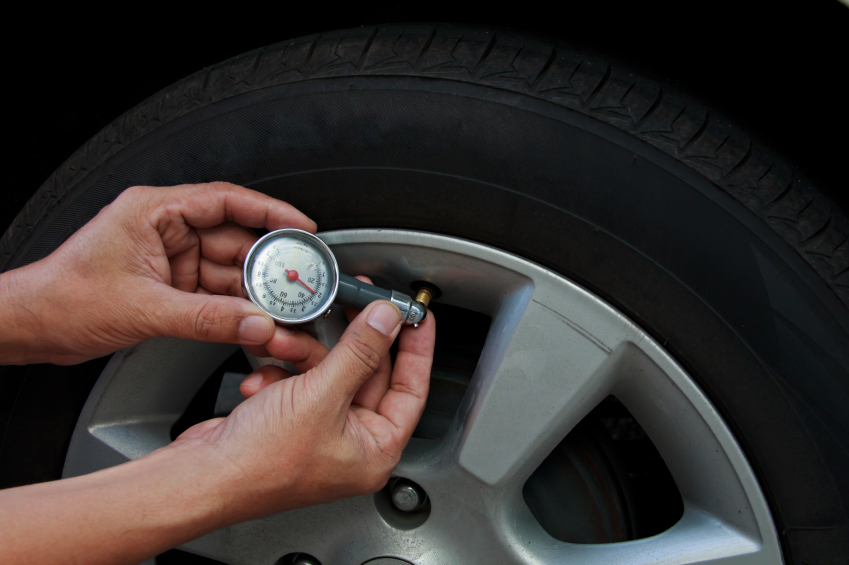 In addition, with excessive pressure, the car rolls well on both flat and uneven surfaces.
In addition, with excessive pressure, the car rolls well on both flat and uneven surfaces.
The most common, convenient, and accurate method of measuring pressure is with a pressure gauge built into an air compressor. It can be found at service stations or specialized gas stations, or you can purchase a portable device for personal use at an auto shop. Depending on the version, there are three types of such equipment on the market:
In addition, there is an alternative to pressure gauges on the market - special electronic sensors made in the form of caps. They constantly determine the level of pressure in the tire and allow you to control the degree of inflation without additional equipment. Sensors with a transparent upper part are installed on each nipple. Depending on the pressure indicator, the transparent part is painted in a certain color:
They constantly determine the level of pressure in the tire and allow you to control the degree of inflation without additional equipment. Sensors with a transparent upper part are installed on each nipple. Depending on the pressure indicator, the transparent part is painted in a certain color:
The most accurate solution is offered by the Tire Pressure Monitor System (TPMS), which is already installed on many modern cars in factory conveyor conditions. In this case, the electronics independently determines the change in tire pressure and notifies about it using the on-board computer. Today TPMS is represented by several types:
 Based on these ratios, the system determines the pressure level and detects the problem, which alerts the driver, but without transmitting accurate data.
Based on these ratios, the system determines the pressure level and detects the problem, which alerts the driver, but without transmitting accurate data. The main mistake that car owners make is to measure the air pressure in the tires after a long trip or after the car has stood in the sun for a long time. To get up-to-date data, check the tire pressure when the tires are cold. The best time for this is the morning hours. If the car has driven several tens of kilometers or stood in the heat, the results will not be correct.
The level determination process itself is carried out as follows:
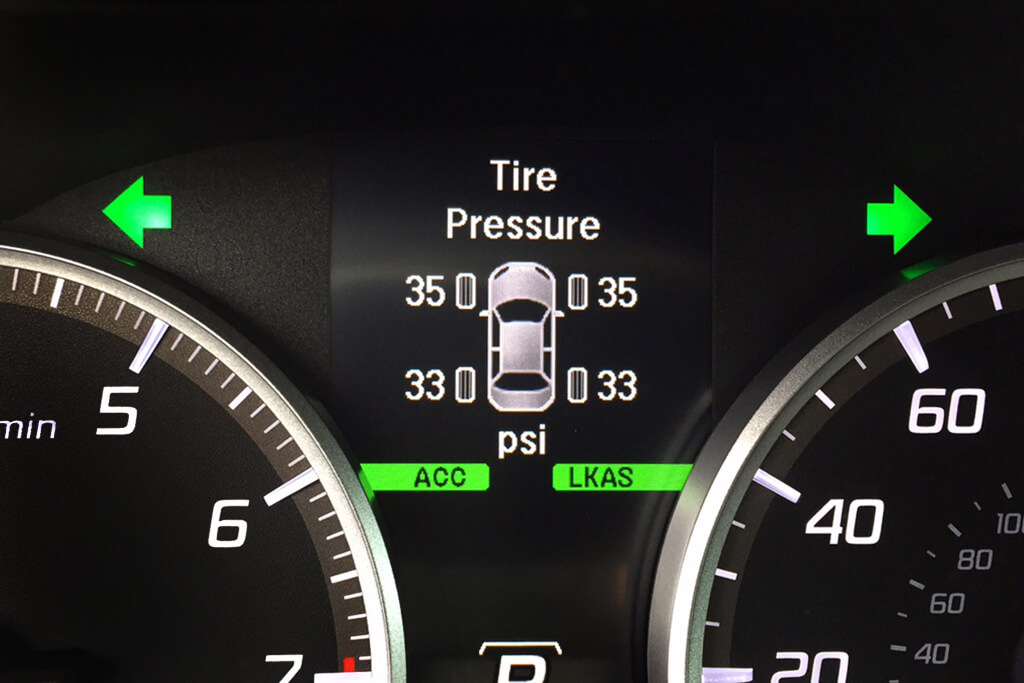
If the pressure level deviates up or down, it is necessary to correct this indicator by dropping or increasing the amount of air in the wheels and reinstalling the cap on the air valve.
This procedure must be carried out in each case for all four tires. With regular changes in pressure, it is necessary to have the wheels checked by a professional workshop.
Different units are used to measure pressure. In Russia, this indicator is determined in bars (bar) and atmospheres (kg / cm²). Both measurement options are used as synonyms, since they are almost identical to each other: 0.9869 atm=1 bar.
For foreign models, this parameter is determined by the ratio of pounds per square inch and is indicated by "psi", which differs from the bar value: 1 bar = 14.5 psi. Due to the difference in values and the need to calculate the rate using formulas, many manufacturers indicate the optimal pressure in several units at a time.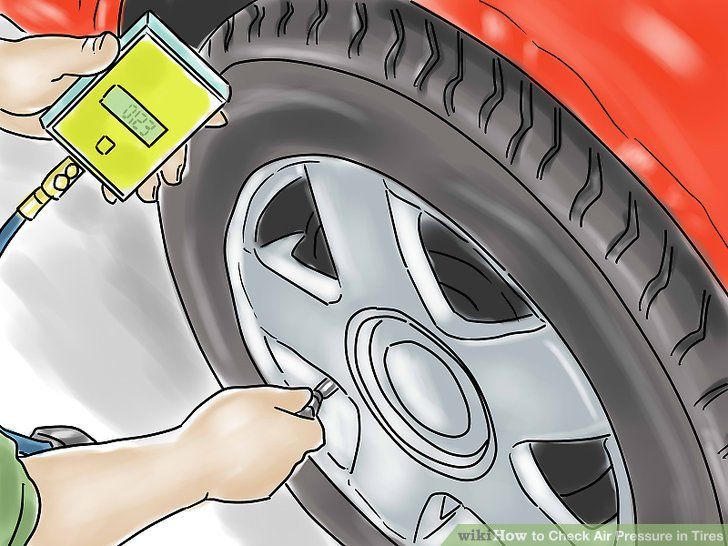 In other cases, you can use the standard table of unit ratios for the most common values:
In other cases, you can use the standard table of unit ratios for the most common values:
| bar | 2 | 2.2 | 2.5 | 2.7 | 2.9 |
| psi | 29 | 32 | 36 | 39 | 42 |
Anyone, even a novice driver, knows that tire pressure directly depends on the ambient temperature. When it gets cold, it drops, and during hot weather, on the contrary, it rises. As practice shows, deviations from the norm are observed even if the temperature fluctuates between 7–9 degrees.
When using summer tires in the warm season, it is recommended to follow the manufacturer's recommendations, and when using it in autumn or winter, it is necessary to add about 0.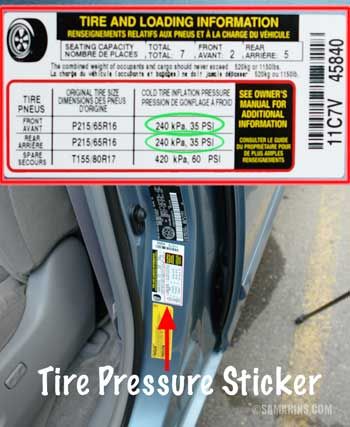 2 bar to these figures, since on average the wheel regularly bleeds air in the range from 0.07 to 0.14 bar.
2 bar to these figures, since on average the wheel regularly bleeds air in the range from 0.07 to 0.14 bar.
It is better to inflate outdoors, and not in a warm garage, since in this case the data will be incorrect and when the car leaves the open area, the tire pressure level will be lower than that which was inflated in the heat. In the summer, before checking and pumping, you should make sure that the car was not standing under the rays of the scorching sun.
When pumping air into the wheels in the summer, it is better to under-pump a little. This is due to the fact that during the heat the roadway also heats up, which increases the contact patch with the surface and, as a result, friction. These factors provoke heating of the air in the wheel, its expansion and an increase in the atmosphere under the tire up to 15%. In winter, a different picture is observed. In severe frost, after the car has left a warm room, there is a sharp compression of the air, so it is better to increase the pressure in the tires of the car in winter.